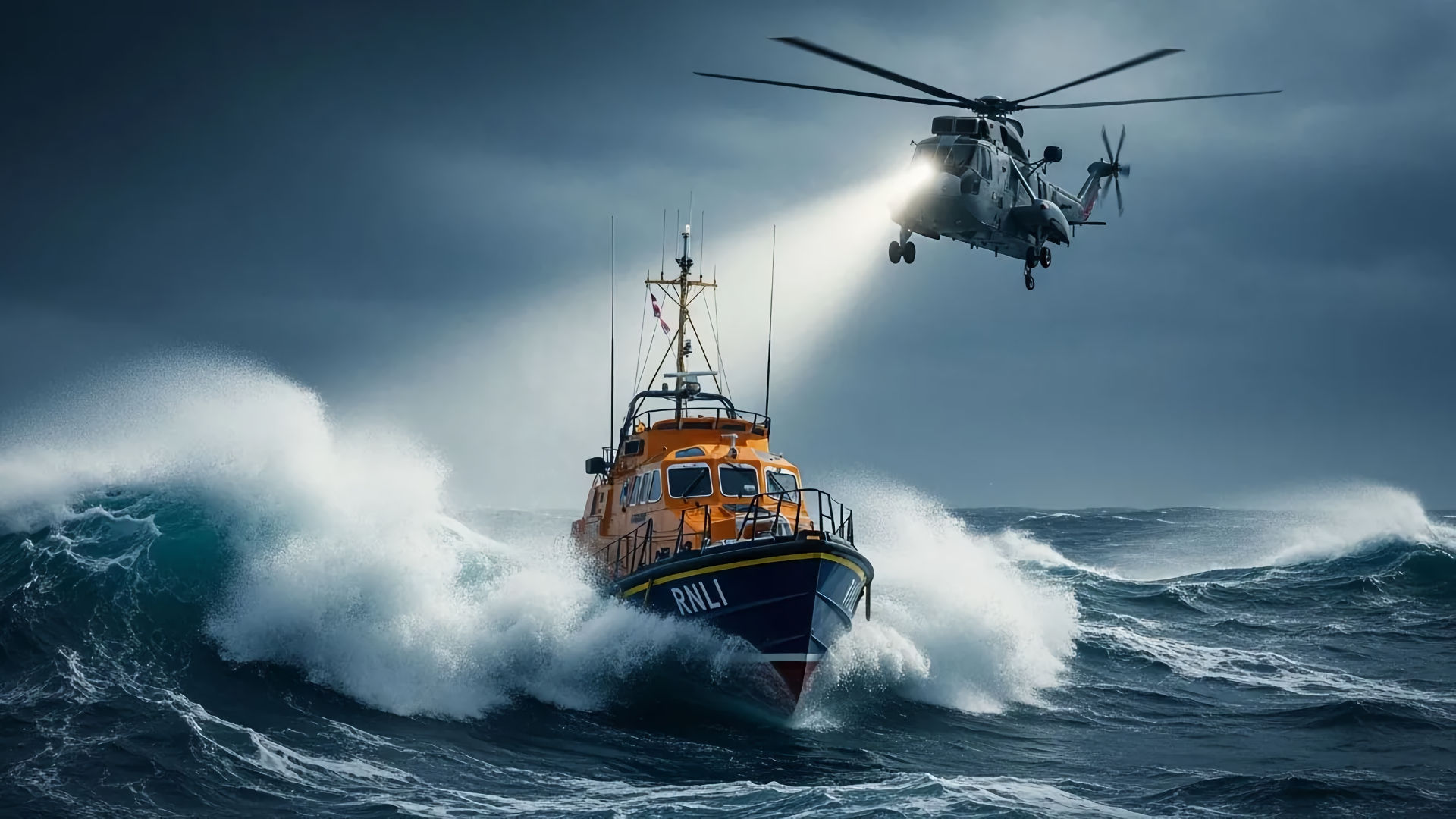The History of Saving Lives at Sea
From ancient fishermen navigating treacherous coastlines to modern rescue helicopters braving storms, the history of saving lives at sea is one of courage, innovation, and enduring human spirit. Across centuries and continents, seafarers and coastal communities have faced the immense dangers of the ocean, leading to the development of heroic efforts and dedicated institutions focused on maritime rescue and safety. This is the story of how saving lives at sea evolved from informal acts of bravery to organised, high-tech global networks.
Early Maritime Rescues
Long before formal rescue organisations existed, acts of sea rescue were often spontaneous, driven by necessity or compassion. Coastal communities around the world developed their own informal methods of aiding stranded or shipwrecked sailors. The ancient Greeks and Romans sometimes used boats to rescue distressed ships, while in medieval Europe, local fishermen risked their lives to save others caught in storms.
In many cultures, the sea was seen as a force of nature not to be trifled with. Superstition and fear of divine wrath often discouraged active rescue. Nevertheless, brave individuals stepped forward when disaster struck, relying on instinct, basic rowing vessels, and sheer determination.
The Rise of Lifesaving Institutions
The idea of organised sea rescue began to take root in the 18th century. In the Netherlands, although not a formal lifeboat service, the Maatschappij tot Redding van Drenkelingen was founded in 1767 as an organisation that focused on resuscitating people who had drowned. The earliest known boat permanently retained for rescue purposes was in Formby, Lancashire, UK, in 1777, with the first known lifeboat station established at Bamburgh Castle in 1786. In 1824, the Royal National Lifeboat Institution (RNLI) was founded by Sir William Hillary with the intent of establishing a coordinated national service for saving lives at sea, and it remains one of the most respected lifesaving organisations in the world. Sir William Hillary’s family motto, “with courage, nothing is impossible,” continues to inspire lifeboat crews.
The RNLI developed purpose-built lifeboats, trained crews, and constructed boathouses and launch ramps. Its early lifeboats were rowed by volunteers and designed to be self-righting in case of capsizing.
Innovations in Rescue Technology
The 19th and 20th centuries saw significant advances in lifesaving technology. New lifeboat designs incorporated watertight compartments, buoyancy aids, and improved propulsion systems. Steam and later motor engines allowed for faster response times and greater range.
Communication breakthroughs also transformed rescue operations. The invention of the telegraph and, later, wireless radio enabled ships in distress to send emergency signals. The iconic SOS distress call, introduced in the early 20th century, became a universal symbol of maritime emergency.
Perhaps one of the most pivotal moments in rescue history came with the sinking of the RMS Titanic in 1912. The disaster highlighted the need for improved safety standards, leading to the 1914 International Convention for the Safety of Life at Sea (SOLAS). This treaty laid the foundation for modern maritime safety regulations.
Helicopters and Air-Sea Rescue
World War II accelerated the development of air-sea rescue techniques. Helicopters, initially crude and experimental, became essential tools for quickly reaching victims, especially in remote or rugged terrain. The British Royal Air Force and the US Coast Guard were early adopters of airborne rescue units.
By the mid-20th century, helicopters were a common sight in sea rescue operations. Their ability to hover, winch survivors from the water, and cover vast distances made them indispensable. They complemented traditional lifeboats, especially in extreme weather where launching boats was impossible.
Search and rescue (SAR) organisations worldwide invest in specialised aircraft, rescue divers, and medical personnel trained to operate in maritime conditions. These airborne teams can perform rescues hundreds of miles offshore, saving lives that might have been lost otherwise.
Global Search and Rescue Coordination
Today, maritime rescue is a coordinated global effort. Most nations operate a Maritime Rescue Coordination Centre (MRCC), which oversees search and rescue operations in designated sea zones. These centres receive distress calls, deploy assets, and liaise with other countries during international incidents.
The International Maritime Organisation (IMO) and the International Aeronautical and Maritime Search and Rescue (IAMSAR) Manual provide guidance for consistent practices worldwide. Technology plays a significant role, with satellites, GPS tracking, and automated identification systems (AIS) enabling the faster location of ships in distress.
Volunteers still play a vital role, especially in organisations like the RNLI and Germany’s DGzRS. Many local lifeboat crews are composed entirely of trained civilians who respond to emergency callouts regardless of time or weather.
Notable Rescues in History
For example, in 1956, the rescue of over 1,000 passengers from the sinking SS Andrea Doria after a collision off the coast of Nantucket became a landmark event in modern rescue operations. Coordinated efforts between ships, helicopters, and lifeboats demonstrated the effectiveness of multi-agency response.
More recently, in 2012, the Costa Concordia disaster near the Italian island of Giglio saw a massive rescue operation involving the Italian Coast Guard, divers, helicopters, and nearby vessels. Though 32 lives were tragically lost, over 4,000 people were safely evacuated.
Training, Preparation, and Risk
Saving lives at sea is not just about the moment of rescue; it requires intensive training, preparation, and ongoing vigilance. Rescue personnel undergo rigorous instruction in navigation, first aid, firefighting, and survival skills. Equipment must be regularly tested, and drills are conducted in simulated disaster scenarios to ensure readiness.
Despite precautions, sea rescue remains a dangerous profession. Rescuers face unpredictable conditions, physical strain, and emotional toll. Yet many are volunteers, motivated by a sense of duty and a desire to give back to their community.
Public education and prevention efforts play a crucial role in saving lives. Organisations run awareness campaigns about wearing life jackets, checking weather forecasts, and following safety regulations.
Looking to the Future
As climate change increases the frequency of extreme weather events, the need for advanced maritime rescue capabilities is growing. Rising sea levels and stronger storms may lead to more shipwrecks, coastal flooding, and offshore emergencies.
Technological advancements offer new tools. Drones are being tested for rapid deployment to locate survivors, while autonomous lifeboats could respond to emergencies without putting human rescuers at risk. Improved satellite coverage and artificial intelligence may also enhance coordination and prediction of maritime disasters.
At the same time, the spirit of sea rescue endures. From ancient mariners rowing into storms to modern crews descending from helicopters, the commitment to save lives has never wavered. It’s a story of compassion, bravery, and resilience.
Final Word
The history of saving lives at sea is a testament to humanity’s determination to protect and preserve life, even in the most hostile environments. Whether through wooden lifeboats or modern turbine-powered helicopters, the mission remains the same: to reach those in peril and bring them home safely. As long as people take to the sea, there will be others willing to answer their call for help.
The History of Saving Lives at Sea FAQ
Organised sea rescue efforts began in the 18th century, with early lifeboat designs and volunteer rescue groups emerging in coastal communities across Europe.
The RNLI (Royal National Lifeboat Institution) is a UK-based charity founded in 1824 that provides 24/7 search and rescue services. It has saved over 144,000 lives and is entirely funded by donations.
Sea rescue has evolved from rowing boats and signal flags to GPS systems, helicopters, fast lifeboats, and real-time communications, greatly increasing survival rates in maritime emergencies.
Yes, many nations have coast guards, and international organisations like the IMO (International Maritime Organisation) coordinate safety protocols and standards across borders.






